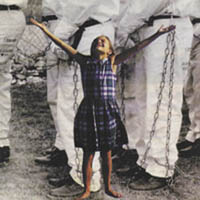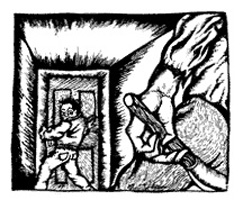 Underground Station
Underground Station
by Bruce Sweeney
illustration by George Metzger
My life and pop culture has gotten a bit more complex since underground comix (u.g.’s) first got started in the late ’60’s. They were practically invented by Robert Crumb, who allegedly sold his initial Zaps on the streets of Berkeley. Also emerging were Bijou, by Jay Lynch and Skip Williamson from Chicago, and Gilbert Shelton (a.k.a. Foolbert Sturgeon) was doing his zany Fabulous Furry Freak Brothers from the campus at Austin, Texas. Many of these independent and uncensored comix were an outgrowth of such early underground papers as the Berkeley Barb, the Chicago Seed and the East Village Other; homes to many of the early comix contributors.
Underground comix were an early outburst of ’60s energy that broke all convention and connections with the pre-teen giants like Marvel Comics and D.C.’s Superman. The burst of premature energy of the fifties’ E.C. comics line with their prediliction for horror, science fiction and a teen/post-teen market was stopped dead in its innovative tracks in the mid-’50s by the Comics Code, a right-wing sentry that only pushed creativity underground for a few short years.
Any Sociology minor, or the equivalent, knows that by 1964 all hell would break loose in American pop culture. James Dean would evolve to Dustin Hoffman and Jack Nicholson; Chuck Berry and Jerry Lee Lewis would naturally lead to the Stones and the Beatles; Marilyn Monroe would go and Kathleen Turner would be born; and hot-rod clubs would be replaced by bikers.
It all changed dramatically and in three to five years. Vietnam would emerge as an American scourge; civil and women’s rights would become social forces, jeans and pot would replace blazers and cocktails, and an obscure niche, underground comix, set ablaze by long-haired oddballs like Art Speigelman, the ever-crazed S. Clay Wilson, Spain, and the tragic Vaughn Bodé would have to emerge. Why not? Everything else was going bananas; why not comics?
U.G.’s have evolved as all of pop has and I have a bitch of a time sometimes telling where Gary Larson leaves off and a lot of the ribald outlaw material cuts in. It isn’t clear anymore and $25 a month won’t keep me up to date or on top of it like it used to.
The comix market has shrunk – paper costs rocketed in 1996 – and dozens of tiny publishers fight over 15 % of the market, while the top three comics publishers fight to stay out of receivership. That’s where I come in. I cover a minority of that 15 % market. I don’t do the sex-oriented stuff; nor the independent super heroes; not quite the Heavy Metals or the Japanese manga or a lot of the fanzine stuff (but you never know…).
Underground comics have evolved to include a lot of the above. To engage in distinctions you’ll see here in this column the representation of the real underground comics; the heroin; the Zappas; the Iggy Pops; the 1%er’s; the harassed and half-mad of comics. This will be the stuff that breaks rules, crosses barriers and embarrasses you in front of your aunt. Underground Station will cover some of the material from Rip-Off Press, Last Gasp, Kitchen Sink, Fantagraphics, Dark Horse and many independently published items as well.
This is nothing to flash through while you’re on the can. This material means something; it cares enough to break rules, dares to misbehave (often at a profit loss), and contests the world around them with highly eccentric art. It’s the cover of Janis Joplin’s first album, it’s the `95 documentary film Crumb, it prevails in truly hip comic shops, and it’s the backroom favorite of the real delinquents and oddballs of the comics industry. In short, its the grass, the rhythm & blues, or the Sundance Film Festival of comics.
At the core of this article then are some of the hot or at least provocative items that have sailed into sight. Of real interest is Robert Crumb’s Art and Beauty Magazine (Kitchen Sink, 320 Riverside Drive, Northhampton, Ma. 01060; $4.95). This is a bizarre all-Crumb rendition of his big-thighed, wide-hipped interpretation of women that is so uniquely Crumb and yet interspersed so much with an homage to the old masters. Their surprisingly concentric adoration of the voluptuous excess of womanly form that so drives Robert Crumb clearly has its antecedents with several important artists. While not an actual underground comic, Art & Beauty is clearly the sensual direction that Robert would have us follow. It is at once fine art and also excessive female form. An instant treasure and a bargain at the price.
Educomics (Box 45831; Seattle, Wa. 98145) is truly comics with a conscience. Leonard Rifas has devoted his entire life to applying comix to, well, propaganda for overlooked causes. His material covers such hot topics as Joe Sacco’s Palestine – an attempt to find objective sense out of that maelstrom of controversy. He also is distributing Harvey Pekar’s award-winning Our Cancer Year, the story of the pluck and success of an average couple battling cancer. Educomics’ latest is Tobacco Comics. This is perhaps comics’ highest level – the urge to apply graphics and narrative to cause and reason. It is no accident that Educomics stocks the National Book Award-winning Maus by Art Speigelman as well as the award-winning gay coming-of-age story, Stick Rubber Baby, the 1996 landmark by Howard Cruse. They also stock the $9 treatment of King, the story of the mighty civil rights leader done by artist Ho Che Anderson. Educomics is one very cool publisher and distributor that single-handedly creates and distributes comix that have real soul and responsibility.
NBM (185 Madison Avenue, New York, N.Y. 10016) has a provocative new European graphic novel out titled Lost in the Alps for $12.95. This is intricate European material for which NBM has great fondness and an established niche.
Myriad Publications (3112 University Ave. Bakersfield, Ca. 93306) has Myriad #1 out for $3.95. The great color cover makes it look like a graphic novel, but it is yet another sci-fi item with 56 pages of black and white interior. Its Asian orientation seems interesting, but for my money these stories should feature either swords or guns. They don’t really go together.
To be quickly hip is to embrace Art ? Alternatives #8. It is so pretty on the newstands and it should be at $7.95. A subsidiary of Outlaw Biker Enterpises, this is indeed alluring stuff. The only problem is that by the time you slow-walk it to the counter, you’ve been through 80% of it. Its problem is that it is so visually impressive, hip and arresting, it’s like your first slice of a Neapolitan pepperoni pizza – lotsa reward but no afterglow. I frankly can’t resist these as they come out, their illustrations are so compelling, but they are $7.95. The answer is to have your roommate go in on half…
Far less Manhattan but still upscale is Bughouse by Steve Lafler (Cathead Comics, P.O. Box 576; Hudson, Ma. 01749). This 120-page graphic novel goes for $12.95 and is about the early days of jazz, with various bugs taking the roles of individuals and races. It outlines their contributions to jazz as an artform and lifestyle. This is a very hip book…
There’s been a burst of autobiographical comics within the underground. Justin Green, Harvey Pekar and Robert Crumb are just a few of the more prolific, but the door has been thrown open for years with artists telling tales of their own personal daily tribulations. It’s a common phenomenon in gay and women’s comics, with the focus more on day-to-day experiences than traditional male shoot-’em-up stories.
An independent comic of autobiographical significance is the home-made Silly Daddy title. (#13 is $2.75. Joe Chiapetta, 2209 Northgate Avenue, N. Riverside, Il. 60546-1339) With 64 pages (6 in color), it focuses on why men get such a bad rap from women. Amazingly, these are stories written from the standpoint of a young father adjusting to early adulthood, family, and marriage wondering whether he’s been saved or lost forever. Weird stuff.
Last Gasp Comics (777 Florida Ave., S.F., CA 94110) probably has out by now The Crumb Family Album. It’s edited by Max Crumb and it’s a $16.95 8 1/2″ X 11″ comic album featuring contributions by all the Crumbs, including Charles, Max, Jesse, Sophie, Alice Kominsky-Crumb and naturally Robert Crumb. It includes a color cover and some color pages.
Last Gasp, like everyone else, has diversified into posters, buttons and unusual books. They are no longer exclusively an underground comic publisher, but two titles to watch for are the all-Crumb Hup #3 and #4.
(The logo adorning this article is by artist and animator George Metzger who has done such great u.g. titles as Truckin’ and Moondog.)



